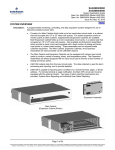Download Share Your Best Tech Project! The Mysterious East Password
Transcript
Spring 2003 scrubbed out softly. If excessive force is applied, you can have a stain on it. Insert the CD provided with the monitor into the CD-ROM Driver. Please wait, as the CD will be executed automatically. CD User Guide: This guide contains usual tips for installing and using the monitor. Read this guide when you have problems before or while using the monitor. Share Your Best Tech Project! The Automation and Technology Division is planning a showcase of "best practices" for library technology, Wednesday, August 20th at the State Library. We believe your work deserves recognition. All 'library technologists' are invited to share their unique solutions and practices with their colleagues from around the state at TheRightClick v 1.0 See our web site at http://www.therightclick.info for more information! The Mysterious East Robert Wenz, Lorain Public Library The following information, unedited, is found in the user manual for our Samsung SyncMaster 151s LCD monitors (which we love, by the way!): Set the front of your monitor to face the east if possible. The colors, bend and tilt of the screen may change according to the installation direction. When you clean the monitor and the panel outside, please apply the recommended small amount of cleaner by using soft and dry cloth and polish it. Let LCD area not to be forced but to be Keep the CD properly as you may need it when moving to another house or reinstalling the monitor. Do not excessively bend the plug and wire nor place heavy objects upon them, which could cause damage. Failure to do so may cause an electric shock or fire. Do not drop the monitor when moving it. This may cause damage to the product or human body. Password Security Part III: How do I Convince THEM it’s a Good Idea? Matthew Hoffman, Cleveland Heights-University Heights Public Library Obviously you don’t really want to start thinking of the rest of your staff as THEM, but in all reality, you’re going to be on different sides of the password-security fence. My last article detailed how to set up password security settings on a Windows NT 4.0 domain. This article will concentrate on how to get your staff, and more importantly your administrators, on the same page with you. Continued…page 2 Password Security Part III…continued Your staff members are probably not going to like the fact that they will now have to remember more complex passwords. They’re even more likely to hate having to change them periodically. So, make sure to come up with a minimal level of security that you feel comfortable working with. Shoot for something higher if you can get it, but have in mind the weakest that you’re willing to allow your security to be before beginning to broach this subject to your staff. I recommend going to your administrators first. In my case, my Director is fairly involved in the processes relating to technology at this library, but many of you may have Directors with a hands-off approach. It may be necessary to explain more background of some of the problems inherent in not implementing password security. In any case, I believe that most administrators will need to have the following explained: 1. Loss of data due to an attack should be seen as loss of productivity, time, and money. If documents or other data are destroyed, then all the work that went into the creation of that data is lost. Worse yet, your staff may have to recreate it! An attack could mean not only loss of data, but corruption of it as well. Any library business manager should be shaking in his boots at the thought of having someone hack his financial system. Additionally, your time is wasted trying to track down the perpetrator. 2. It is quite possible that an attack on your system means that the hacker is attempting to attack another site through you. Any police involvement may mean that you are investigated as well. Beyond that, if anything of real value is destroyed or stolen, you may be held legally responsible! 3. You have a responsibility as an organization to the rest of the Internet Community at large (this is, of course, assuming that your organization has such access). You wouldn’t want other organizations to be wide open as conduits for attacking your library, so you should follow the same philosophy. I think that most administrators, given the above information delivered to them in a factual and logical manner, will see your point. This is vitally important because with their support your staff will have little choice but to follow the plan. However, it is also important to try and soften the blow as much as possible. Once you have your administrator’s support, you find a way to get your various department heads/supervisors together for a question and answer session about the impact your plan will have on the staff. Prepare materials for them on what you are going to be doing and what is required of their staff. Make sure they understand the same points you made to your administrators and give them some specifics of how and when you are going to implement this change. Lastly, I suggest putting together some sort of training session for your staff on this subject. Yes, as techies, we don’t like actual personal contact, but sometimes it really is necessary for THEM to see US. My experience has been that no matter how many times you e-mail instructions/ warnings/threats, etc. staff, the results are not good. Direct face-to-face contact seems to work best, especially when explaining the Continued…page 3 Password Security Part III…continued reasons why it is necessary for staff to be part of the security solution, rather than part of the problem. I’ve found that the results of this sort of training are quite positive. In closing, I’ve found that the key seems to be finding that happy medium between the need for security and the needs of your busy staff. Keep things simple enough that they can deal with it (and, yes, a little growth on their part should be necessary) but make sure that your standards are being met. Keep your humor, patience, and crossed fingers ready at all times and good luck! Ask the Webmaster Send your questions to [email protected] Q: What is cross-browser compatibility and why should I care? A: This means that your web site looks and acts the same way in more than one browser. Not all browsers interpret HTML and/or CSS in the same way. It is important that you keep in mind those visitors using less well-known web browsers, such as Opera, Mozilla, Konqueror and even Netscape 4x. Not everybody uses the latest version of Microsoft Internet Explorer! So download other browsers and test your site in each before releasing it for public use. You Can Take It With You! : Web Tablets in Libraries Kathy Schnell and Nick Cronin, Cuyahoga Public Library Technology devices like Web tablets have great appeal today in the information business. Adapting this technology for use in the public library is an attractive idea. Patrons learn that you are ahead of the technology game and are keeping pace with the future. Are you considering adopting Web tablets in your library? If so, here are some ideas we can share with you. Wireless Technology Web tablet use is supported by wireless technology. You need the hubs and hardware and spatial configurations to make wireless devices work. If you are part of a multi-branch library, each building will probably have wireless issues unique to itself. Advantages/Disadvantages (more information about this in the article below) What are the advantages of Web tablets? They are portable. They tablets are not cheap, but they are cheaper than laptops, and since they are network connected, you can avoid the peripheral issues of lengthy start-ups, virus contamination, and downloading complications. Their small size makes them easy to store and keeps them readily accessible. What are the disadvantages? They are more likely to “walk” out of the library. Without a keyboard, they are not ideal for email and messaging, which can be considered either a disadvantage or an attractive advantage in a public library! Administration & Staff Use The portable tablets can make weeding more efficient as staff can refer to an item’s circulation record while working right in the Continued….page 4 You Can Take It With You!…continued stacks. Tablets can also have scanner attachments to easily make a record of books in the stack. This record can be accessed later when staff may be tied to their desk while serving patrons. Inventory work can be streamlined because the portable tablets allow them to be taken right to where the equipment is stored. Scanners can read and add barcodes into a database. This allows staff to work with the items wherever they are located, and enter inventory records with lower risk of human error. Other applications can be suited to the size and needs of your library /library system. Patron Use A real life story of patrons using Web tablets at a public library follows, submitted by Nick Cronin, head of Adult Reference at Cuyahoga County Public Library’s Fairview Regional Library. Web Tablets: The Ten Commandments Sometimes it seems new technology is so pervasive that, as librarians, we simply don’t know what new items and devices to test. The array of e-books and personal computing devices is so vast that it is ever more challenging to know what we should present to the life blood of public libraries everywhere, the patrons. Recently, Fairview Park Regional Library engaged in a pilot project with portable Web tablets. The project was designed to see if library customers were ready and willing to adapt to a technology, which has been, until now, largely untested in a public library setting. The tablets were in addition to 20 traditional (gosh, are they traditional already?!) Internet stations available to the public. We thought that customers might be so enthusiastic they would move away from static terminals thus lessening the number of times staff would have to be involved in the dreaded “bumping” conversation. You know the one: “Excuse me sir, somebody is signed up to use this station.” “The heck you say. I’m getting this e-mail printed come hell or high water.” “I understand sir. However, ……” Yes, we have all been there. And has one of us found the ideal way to cope with that stressful situation? Web tablets were the answer. They had to be! Look at all the advantages. You can take them to an easy chair, use them in comfort away from prying eyes (and therein lies a whole other conversation…), set them up on your knees or your lap and browse away the hours. The only time constraint is the batteries running out and we were pleasantly surprised to discover that they lasted well over two hours. So, how did it go? If I were a politician I would probably blind you with a series of bland explanations, which would leave you no wiser than you were before. Being a member of an honest and trustworthy profession I can tell you the truth as I see it. That truth is that Web tablets will work in your library, but only if you make them. From the start of our project the most obvious problem was that of publicity. How were we to let people know we had nine portable Web tablets? (Additionally, where were we to keep them? Web tablets are not Continued….page 5 You Can Take It With You!…continued large. They are about the same width as an etch-a-sketch, but rather thicker and heavier. However, they need to be nourished and recharged on specially designed cradles, so there is a slight space problem in a confined environment. Our solution was to store them at our circulation desk. The issue of security dictated that we ask patrons to surrender their library card and to, in essence, ‘check out’ a Web tablet.) Publicity was the key question though. How much advertising should we do and what wording would we use? After all, if one says to a public library patron, “we are delighted to be able to tell you we have nine portable Web tablets” there is a fair to good chance that they will greet you with a blank stare and then back slowly away…. It’s worth noting that libraries considering the use of Web tablets might look at publicizing them on their Web site, in library newsletters, at media outlets and so on. At Fairview Park we decided on simply worded signage placed at strategic areas in the library. One obvious location for a sign was by the regular Internet sign up sheet. Another was by the reception desk and yet another by our self-check machine. Good enough we thought. If we advertise it they will come. But they didn’t, at least not in the numbers we had expected. There were a few polite enquiries, which were greeted with enthusiastic explanations by library staff. These were usually followed by the patron’s assurance that they would return to test the tablets “another time.” Some intrepid souls did go to the trouble of checking them out and they claimed to enjoy their experience. One job-hunting man expressed obvious delight, used his tablet until the batteries died and then gleefully went to get another one. However, in general, people did not come back to use the tablets again. Why was this? There are a number of logical explanations. The first and most obvious is that, like it or loathe it, a large percentage of people use the Internet for e-mail and chat. Web tablets are not conducive to either form of communication unless they come with a keyboard. Ours did not, so people were composing e-mail and chatting to people (who doubtless thought they were terrible typists), using the stylus, which comes as part of the Web tablet package. Tap the screen on a hyperlink and you are magically whisked to another site, but tap the pop up screen keyboard and you get one letter. Thus, the planned letter to mom and dad might go something like this; “Dear mom and dad, I am fine. Bye, Rick.” The lesson to be learned? If you know that the majority of your patrons use e-mail or chat, get keyboards for your Web tablets. Without a keyboard they are great Web and database browsers. No more and no less. The next issue was printing. Initially at Fairview Park we had no network printer. A number of people mentioned this was a drawback for them. We spotted one man, having found the information he was looking for on a Web tablet, taking the device to a regular Internet station so he could use the printer that was attached there! And the lesson to be learned here? People want to print from the Internet. Generally, people have a specific objective when they go online. When they find it, they love to print it whether it is e-mail, an article from a newspaper, a stock report, or the latest Continued….page 6 You Can Take It With You!…continued terrible Internet joke. Give them that printing option and put your network printer in a central location so they don’t have to wander too far to find their printouts. Another issue is that of training. Staff members were wary of the Web tablets as they thought patrons were going to require intensive training. This would have meant another shot across the bow of the technology warship. We all know how much time reference desk staff spends assisting patrons with IT. Every day we deal with word processing problems, Internet freezes, new and more sophisticated databases, dirty mice, toner cartridges exploding on white clothing and so on. How would we deal with yet another technology training issue on the front lines of reference service? The answer here was extremely positive. Generally, staff found that patrons needed no more than a quick introduction. Two minutes learning how to use the stylus and the pop up keyboard, and a few more minutes learning how to put in an Internet address. That was really all we needed to do. Most people would then take their tablet away to one of our easy chairs and that was the end of our Web tablet interaction with them. As time went by, however, we discovered that the Web tablets were still not being used as frequently as we had hoped. Our regular Internet stations were as busy as ever and patrons were prepared to wait for an open terminal rather than use the tablets. Why was this? Perhaps the ‘inconvenience’ of having to ‘check out’ the tablets at the circulation desk with their library card, perhaps the difficulty of composing e-mail, perhaps because the tried and tested Internet stations were just a more comfortable place to be. Whatever the reason we decided to give the Web tablets one final push. We stationed staff on the first floor near the entrance to the library and engaged patrons in conversation about the tablets. We demonstrated tablets galore, encouraged people to try them, told them about the many benefits, as we understood them, and ultimately did everything we could do to convince people that this was the way to go. Of course that begs the question, are Web tablets really the way to go? I am in two minds about this. Certainly, for libraries with limited space for additional stations, they are a realistic alternative. At the same time, as we have seen, there are many issues to be addressed and it is best to be aware of these issues before buying in bulk (buyer beware, Web tablets are not exactly cheap!). Remember that wireless technology means installing wireless hubs throughout your building, and never, never forget that many of your patrons will not understand that the tablets only work at the library. Yes, there is a very real possibility that your Web tablets will disappear in the backpack of a thief who thinks that it might be fun to have free Internet access at home! This means that, while not exactly having to place them under lock and key, libraries wanting to experiment with Web tablets do need to implement considered security precautions. This might mean requiring patrons to surrender their library card while using a tablet. It also presupposes that all Web tablets will be tagged with some sort of security strip, and that staff will be diligent in tracking the movement of tablets throughout the library. Be prepared to accept some losses, not necessarily of the entire tablet, but perhaps of a stylus or two, and possibly even of an Continued….page 7 You Can Take It With You!…continued antenna as an overly enthusiastic user tries to remove it thinking that it is an extra stylus. Perhaps, given the fact that they are tablets, we might end with Ten Commandments for those libraries that would like to investigate the feasibility of these devices. The Ten Web Tablet Commandments 1. Thou shalt not purchase dozens of Web tablets in a blind leap of faith. Remember, they are fairly expensive. 2. Thou shalt supply keyboards for your e-mailing and chatting patrons. 3. Thou shalt connect a network printer. 4. Thou shalt not blind thy patrons with Web tablet jargon. 5. Thou shalt publicize thine Web tablets. 6. Thou shalt security strip thine Web tablets. 7. Thou shalt ask thy patrons to surrender their library card when checking out thine Web tablets. 8. Thou shalt reassure thy staff that everything will be ok☺. 9. Thou shalt continue to publicize thine Web tablets! 10. Thou shalt get ready for the next new technology and take these lessons on board!
















